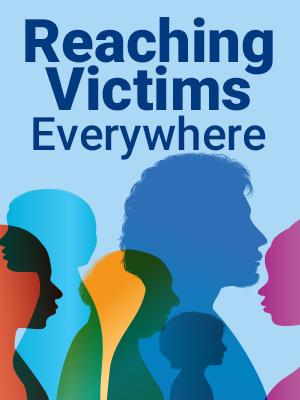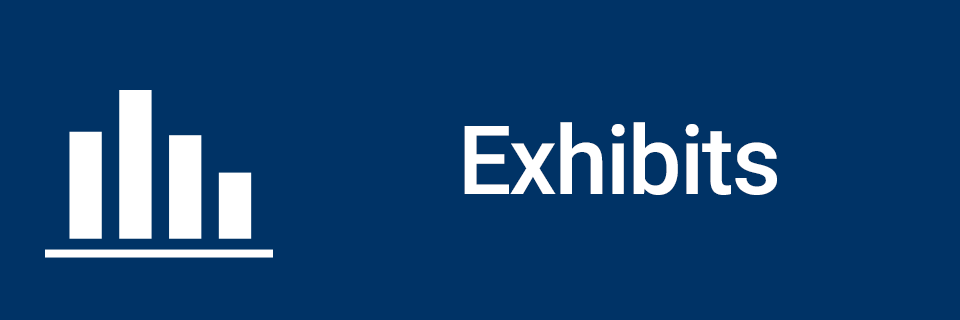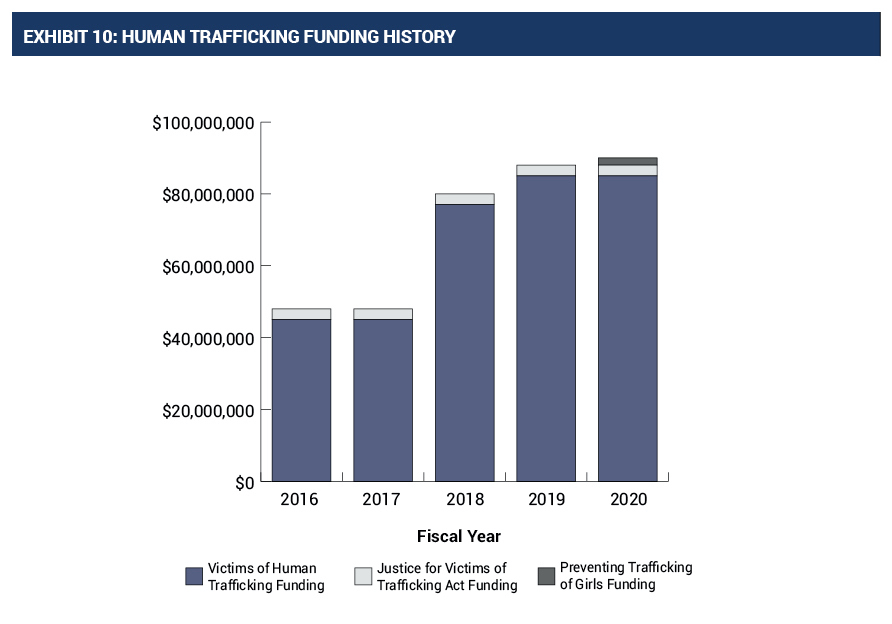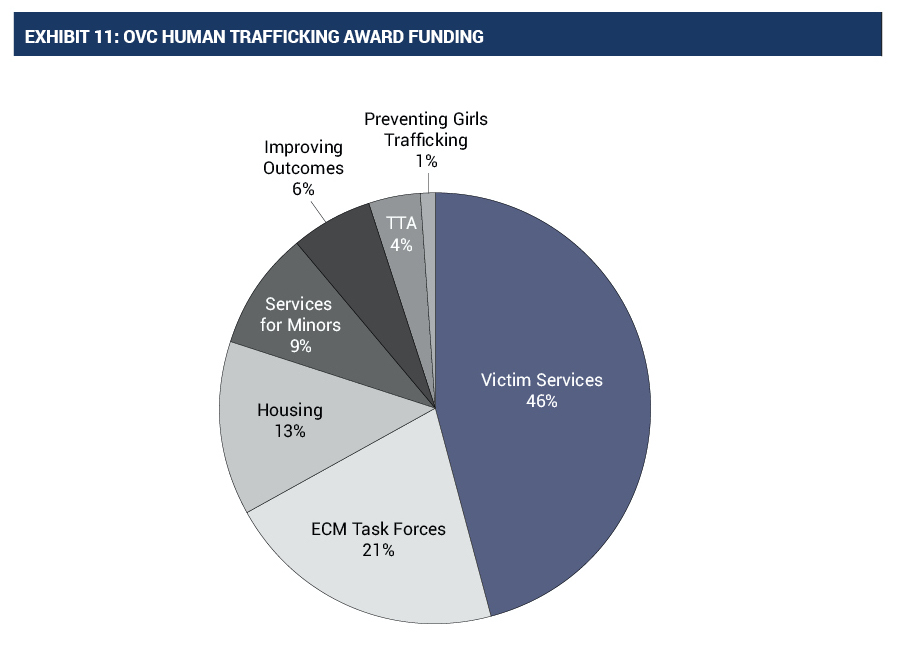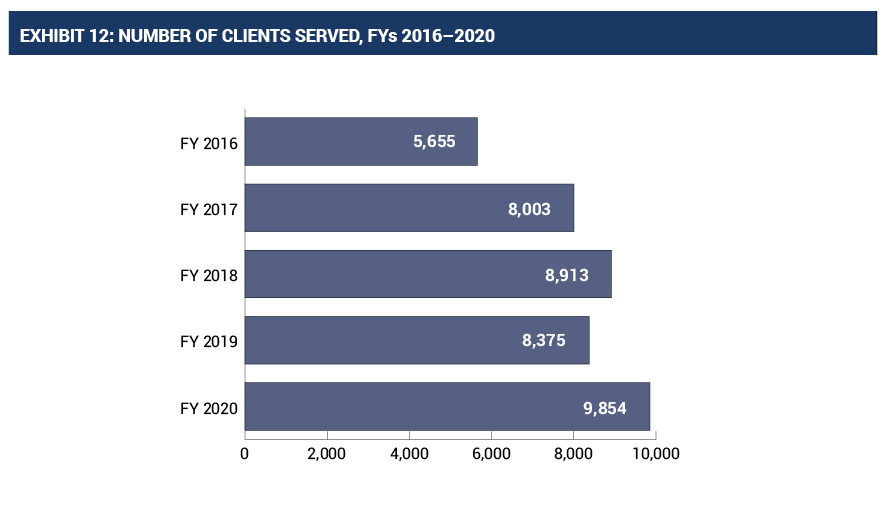Archival Notice
This is an archive page that is no longer being updated. It may contain outdated information and links may no longer function as originally intended.
Combating Human Trafficking
With funding appropriated through the Victims of Trafficking and Violence Protection Act, OVC administers the largest amount of federal funding dedicated to responding to human trafficking in the United States.
OVC funding supports the delivery of direct services such as case management, housing, legal assistance, and multidisciplinary collaboration and state-level approaches to identifying and serving victims of human trafficking. In addition, through contracts and cooperative agreements, OVC manages a broad array of training and technical assistance (TTA) for victim service providers, law enforcement, and allied professionals, with a focus on enhancing the quality and quantity of services available to trafficking victims and grants to build capacity. To enhance anti-trafficking programming and policies, OVC engages in ongoing interagency and intra-agency collaboration and seeks out opportunities to learn from survivors, service providers, and other frontline stakeholders throughout the country.
In June 2020, the Office of Justice Programs (OJP) consolidated all law enforcement, juvenile justice, and victim services anti-human trafficking initiatives at the Bureau of Justice Assistance (BJA) and the Office of Juvenile Justice and Delinquency Prevention (OJJDP) into a new Human Trafficking Division housed within OVC. The goals of this consolidation include implementing a unified approach to TTA content and delivery; ensuring consistent messaging around best practices and the importance of victim-centered, trauma-informed strategies; and avoiding duplication of efforts across OJP offices. In adopting this approach, OJP is modeling the same multidisciplinary approach employed by human trafficking task forces—one that best addresses the needs of trafficking victims and more effectively integrates a victim-centered, trauma-informed approach into the criminal justice system. With this consolidation, OVC established a comprehensive set of performance metrics for all anti-human trafficking programs to standardize metrics across the agency, reduce burden on grantees, and accurately reflect the work of the grantees. This data will help OVC understand grantees’ progress in meeting goals and objectives and make informed decisions on program improvements.
OVC’s funding has increased significantly over the past 5 years, which has allowed OVC to intensify its efforts on behalf of trafficking victims, announce new initiatives, expand existing programs, and award more than $170 million to grantees in FYs 2019 and 2020 to serve this vulnerable population (see exhibit 10). At the close of FY 2020, OVC was managing 409 active anti-human trafficking awards representing more than $270 million, with grantees in 47 states, one territory, and the District of Columbia. This represents the largest amount of federal funding ever invested at one time in anti-trafficking programming in the United States.
Roughly 68 percent of OVC anti-human trafficking funding goes to direct victim services for human trafficking victims, with some of that funding specifically targeting services for minor victims of sex and labor trafficking (see exhibit 11). One of the new victim services initiatives launched in FY 2020 is a program that focuses specifically on housing assistance for victims of trafficking. OVC funded 73 awards for more than $35 million to support housing programs for survivors of human trafficking, including funding for the operating expenses of a newly developed or existing transitional housing program; and short-term housing assistance, including rental or utilities payment assistance and assistance with related expenses.
Additionally, more than a fifth of OVC funding goes to Enhanced Collaborative Model (ECM) Task Forces to Combat Human Trafficking to support law enforcement agencies and victim service organizations in implementing collaborative, victim-centered, trauma-informed approaches to identifying and serving victims of all types of human trafficking. Approximately 6 percent of OVC funding supports work at the jurisdictional level to encourage states and tribes to develop, enhance, and coordinate programs and activities to improve outcomes for child and youth victims of sex and labor trafficking. Finally, in FY 2020, OVC received funding from the Office of Juvenile Justice and Delinquency Prevention to initiate a trafficking prevention program focused on girls at risk for trafficking.
As a result of the steady increase in funding, service providers reported a corresponding increase in the number of clients served. During the July 2019–June 2020 reporting period, the number of clients served increased by nearly 1,000 from all 4 previous reporting periods.
Approximately 40,800 clients were served from FY 2016 to FY 2020. The number of clients served in each of these fiscal years was more than the number served in the first 10 years of OVC’s anti-trafficking program (5,756). In addition to delivering services, OVC service provider grantees provided anti-trafficking training to more than 67,347 professionals and community partners between July 2019 and June 2020 (see exhibit 12).[1]
Between FY 2019 and FY 2020, ECM task forces opened 5,155 new sex trafficking investigations, 281 new labor trafficking investigations, and 223 new sex and labor trafficking investigations. These new investigations identified 5,375 potential victims of sex trafficking, 2,330 potential victims of labor trafficking, and 363 potential victims of both sex and labor trafficking. The task forces were able to secure 2,217 arrests for sex trafficking, 24 arrests for labor trafficking, and 51 arrests for sex and labor trafficking. Charges were made on 1,241 individuals in sex trafficking cases, 16 individuals in labor trafficking cases, and 21 individuals in both sex and labor trafficking cases. The task forces secured plea bargains, guilty pleas, and guilty by trial pleas in 496 sex trafficking cases, 9 labor trafficking cases, and 22 sex and labor trafficking cases. A total of 4,456 individuals were identified as confirmed trafficking victims—the majority being victims of sex trafficking (4,049)—ranging from 13 and younger to 55 years and older.
Investing in TTA
Through its cadre of anti-human trafficking TTA providers, OVC provides practitioner-driven, evidence-based TTA that is responsive to the particular needs of victim service providers and system stakeholders, their communities, and the victims they serve. As of FY 2020, OVC supports 12 cooperative agreements and 2 contracts that strengthen victim assistance responses to human trafficking (by offering housing, employment, legal services, and responses to labor trafficking) and support multidisciplinary task forces as they build capacity and leadership in identifying human trafficking victims and connecting them to services. In FYs 2019 and 2020, OVC awarded $14.45 million in TTA grants and contracts. OVC TTA providers delivered a wide variety of TTA to help OVC grantees and the field respond to the needs of human trafficking survivors. Some examples, include—
- In FY 2019, with funding from OVC, Freedom Networks' Housing Training and Technical Assistance Project launched its Housing Summits, which support local OVC grantees engaged in housing trafficking survivors and anti-trafficking work. Each of these summits convened 15–30 community partners, such as domestic violence programs, homeless and housing programs, Continuum of Care leads, Housing Authorities, and U.S. Department of Housing and Urban Development offices to address housing for survivors of human trafficking. Each community identified actions that could support their efforts and make housing accessible for trafficking survivors.
- In FYs 2019 and 2020, OVC grantee Futures Without Violence implemented the Promoting Employment Opportunities for Survivors of Trafficking (PEOST) TTA project to increase access to quality educational and employment opportunities for survivors of human trafficking. PEOST hosted the first in-person institute focused on building effective collaborations between and among victim service providers, workforce development programs, and educational institutions. The institute was attended by organizations looking to strengthen their partnerships in communities across the country.
- In FY 2020, OVC launched the Understanding Human Trafficking online training, which offers foundational learning on trauma-informed and victim-centered approaches to human trafficking. The modules are designed to benefit a wide audience, including victim service providers, first responders, government organizations, teachers, students, and members of the general public.
- In 2020, the OVC-funded Development & Operations Roadmap for Multidisciplinary Anti-Human Trafficking Task Forces was released. Developed by OVC grantee the International Association of Chiefs of Police (IACP), the roadmap provides new and experienced anti-human trafficking task forces, including those funded through the ECM Task Force to Combat Human Trafficking program, with guidance to assess and plan task force development from start to sustainability. This tool supports and encourages a collaborative effort among local, state, and federal law enforcement, prosecutors, and victim service providers.
- In FY 2020, the Human Trafficking Capacity Building Center—which OVC funds to help organizations and tribes start, sustain, or grow their anti-trafficking work—launched their website and Resource Library, which includes a range of human trafficking resources in easily digestible formats such as tip sheets, one-page overviews, sample documents, and Q&As.
- OVC’s Framework: Tools to Combat Labor Trafficking project, implemented by the International Rescue Committee, helps service providers and their community partners to identify and provide transformative services to survivors of labor trafficking. Launched in FY 2020, the project hosted three virtual events focused on building interest in and capacity for outreach to labor trafficking survivors.
- In FY 2020, Project TRUST, implemented by the U.S. Committee for Refugees and Immigrants, Inc., released the Human Trafficking Outreach Toolkit to provide service providers with recommendations for developing and disseminating trauma-informed outreach materials, and published a report on the state of trauma-informed care for trafficking survivors.
- In FY 2020, the American University’s Maximizing OVC’s Survivor Assistance in Court Settings (MOSAICS) TTA project provided a range of housing options and advocacy to meet the diverse needs of victims and survivors of human trafficking, including emergency shelter, hotels, rental assistance, and transitional housing. MOSAICS provides trauma-informed services through a culturally competent lens, providing interpretation and translation for multicultural survivors in more than 150 languages through additional in-person and phone interpreter services.
Representing Resilience Through Art
The 20th anniversary of the Trafficking Victims Protection Act was observed in 2020. The Act recognizes the importance of protecting victims, holding traffickers criminally accountable, and preventing victimization from occurring in the first place. In commemoration of the 20th anniversary, OVC launched the Represent Resilience art initiative in summer 2020 to feature original artwork by survivors, advocates, and anti-trafficking professionals across the country.
For additional information, please visit OVC’s anti-human trafficking initiatives website.
[1] This is aggregate data across OVC human trafficking grant programs as reported in Trafficking Information Management System (TIMS) Online from July 2015 through June 2020.


